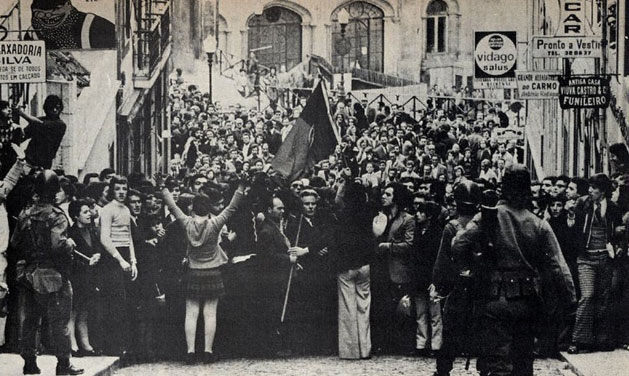

By Dave Stockton
THE 25 APRIL ‘Carnation Revolution’—a mutiny led by junior officers of the Portuguese armed forces—developed into a coup which brought down Europe’s oldest dictatorship. Welcomed by weeks of mass demonstrations by workers, it developed into an 18-month revolutionary situation.
This was marked by several mass strike waves, factory occupations, the establishment of workers’ commissions which imposed control and nationalisation and the occupation of landed estates. Rank and file soldiers built democratic movements in the army, which sided with workers against the government and their own commanders.
Two attempted counter-coups in September 1974 and March ’75 failed to resolve the crisis. In short, there was an extended period of dual power in the country.
Mark Osborn’s pamphlet tells the story of many of these events and the political parties and organisations that took part in them. As such it contains a useful summary for those wishing to study these years.
Its chief weakness lies in its estimate of the two main reformist workers’ parties, the Socialist Party led by Mario Soares and the Portuguese Communist Party led by Alvaro Cunhal. Osborn shows a markedly more severe criticism of the latter as against the former, as well as the much smaller Maoist sects.
Thus, according to Osborn, the CP, despite its influence in the working class and its bravery under fascism, should not have been considered a leftwing party at all. Meanwhile, we are told that ‘the SP was a mass Social Democratic Party with a programme far to the left of the current European Social Democratic parties’. This ahistorical comparison does not tell us anything.
True, Soares played to the left for a few months, while the CP was condemning strikes as irresponsible. But during the critical phase of the revolution—the so-called Hot Summer of ’75—the SP was taking part in right wing demonstrations in the north, which attacked CP offices and meetings.
Soares was in an alliance with the so-called Group of Nine, the right wing of the Armed Forces Movement (MFA) who were determined to restore discipline in the army, in the factories and to halt the land occupations. Winning a majority in the MFA Assembly, they set out to crush the worker-controlled radio station Renascenca and newspaper Republica.
First provoking, and then taking advantage of an abortive revolt by a section of paratroopers, plus the unpreparedness and incompetence of the left-wing officers and the far left, Ramalho Eanes and the Group of Nine sprung a coup on 25 November 1975 that met virtually no resistance.
Counter-revolution
It was not a Chile-style counter-revolution, but a ‘democratic’ one. Nevertheless it ended the revolutionary situation for good. While civil rights were preserved, the nationalised factories and landed estates were handed back to private ownership, the workers’ commissions and workers’ control liquidated.
The most heinous crime of the CP was its outright betrayal of the revolutionary workers and soldiers, by calling off a general strike and openly siding with the reactionary officers in return for keeping their government posts.
It is true, as Osborn argues, that the far left and the most prominent group the Party of the Revolutionary Proletariat (PRP-BR) placed inordinate hopes in the left officers around Otelo Saraiva de Carvalho and the military units in Lisbon. They boycotted elections to the Constituent Assembly in April 1975 and then called on the MFA to dissolve it when not even embryonic organs of working class political power existed.
In fact, the key task was to deploy various forms of united front, aimed at involving the SP and CP’s worker members and placing demands on their leaders to defend and extend the gains in the factories, in the cities and in the countryside. These united fronts could have grown into workers and soldiers’ councils.
They could have drawn in delegates of the rank and file of the reformist parties, i.e. they should have been organs of workers’ democracy. A real struggle to win them to revolutionary leadership could have taken place. Instead, the PRP-BR formed a few ‘revolutionary’ councils which could not possibly play this role.
The impression from Osborn’s pamphlet is that the overriding danger was a Stalinist dictatorship (the same message as Soares’ demagogy) and that the real task was to ‘defend democracy’. Instead, the shattering of the revolutionary hopes, which the events in Portugal had raised across Europe, began a long period of retreat for the working class in the decades to come.